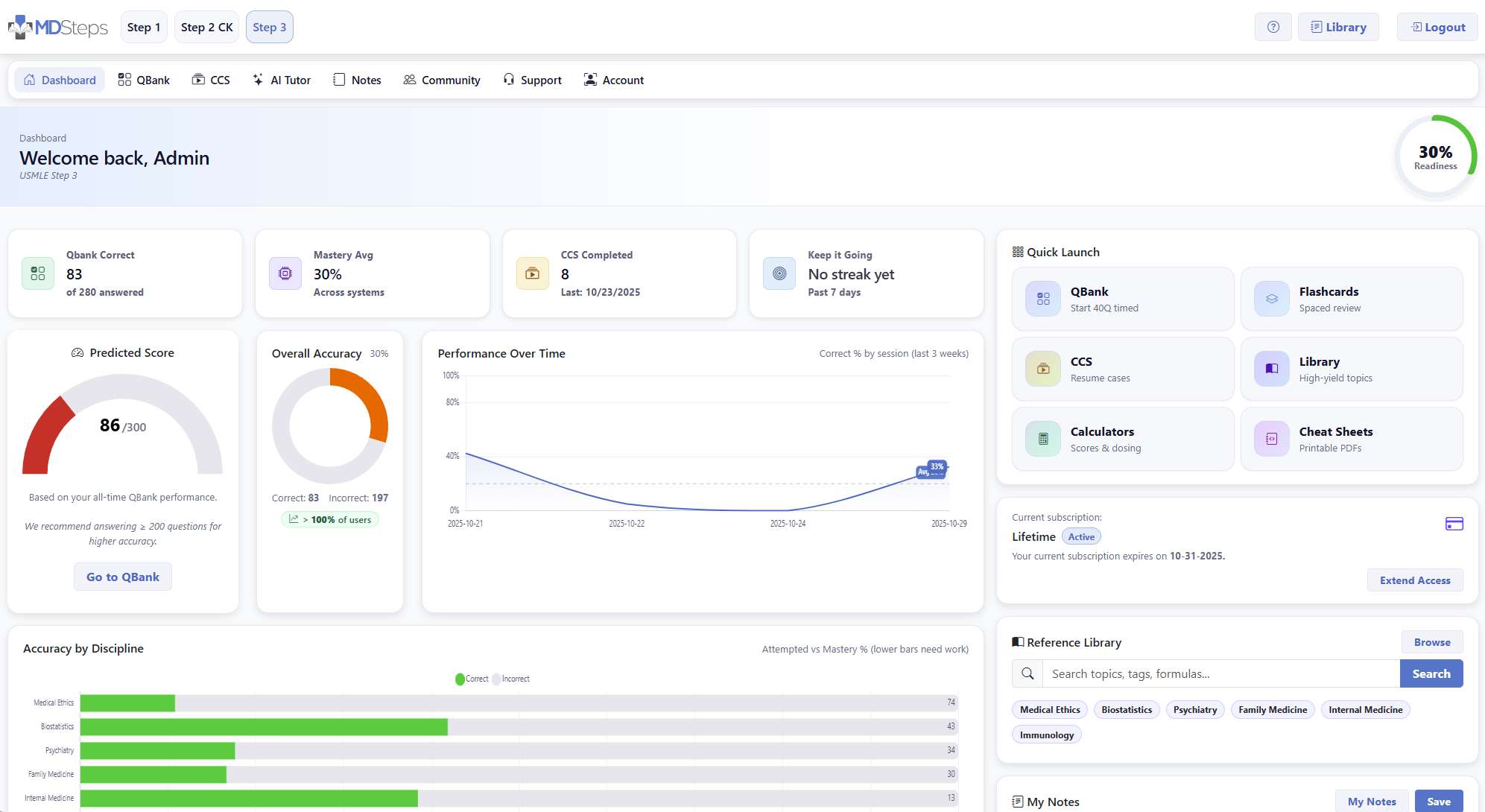USMLE Steps 1–3 • Built for how clinicians think
MDSteps is Different by Design
Students are frustrated with UWorld and AMBOSS. Slow reviews, tricky wording, and score signals that don’t match test day. MDSteps fixes the root causes: faster learning loops, transparent difficulty, and readiness you can trust.

Stats at a glance
Student-reported data; MDSteps times reflect tiered-review designReview time per block
Per-item review flow (MDSteps)
Daily throughput potential (illustrative)
From pain points to product fixes
We hear it all the time. "MDSteps is nothing like UWorld!" We know, and that's the point. We're different by design. We listened to what students say about the big platforms—and built MDSteps to solve those exact problems.
Students report 2–3 hour review slogs with bloated write‑ups that kill momentum.
- Tiered explanations: 30‑sec Why Right → 90‑sec How to Think → full on demand.
- Review clock with soft cap + gentle “wrap and move on” nudge.
Items sometimes feel designed to trap rather than teach, spiking anxiety despite knowing the content.
- Resident‑style Reasoning Trace shows the decision steps explicitly.
- Trickiness Audit: language linting flags ambiguity/false difficulty pre‑publish.
Raw block percentages can mislead and demoralize when they don’t align to NBME outputs.
- Concept Mastery Indices + trend lines with confidence bands.
- NBME‑alignment score calibrated on anonymized outcomes.
Some forms feel off‑calibration; students aren’t sure how much to trust them.
- Intended Use labels (diagnostic vs stress‑test) and Predictive Validity badges.
- Option to exclude outliers from your dashboard and predictor.
Common advice is to distill the learning objective—not the essay—but most tools don’t help you do it.
- 1‑Line Takeaway composer under every item (accept/edit).
- Smart flashcards auto‑generated from your takeaways.
“All‑hammer” sets feel unrealistic and miscalibrated.
- Evidence‑based difficulty via IRT from peer performance.
- Separate Fairness rating: rare disease vs reasoning depth vs distractor traps.
Wordings and emphasis can diverge from NBME/UW style.
- Every item tagged with a Style Profile (NBME‑like, case‑heavy, data‑dense).
- NBME‑style linter pre‑publish; filter by style for exam‑proximal phases.
Great depth—but easy to get lost when you just need a focused fix.
- On a miss, open a micro‑slice (3–5 highlighted paragraphs) tied to your error pattern.
- Two‑minute read target with a progress meter.
Generic “HY200” sets get mixed reviews when it matters most.
- Dynamic HY: a rolling pack mapped to your weakest NBME objectives + most‑missed concepts.
- Overlap heatmaps vs your recent errors.
Starting Step 2 often resurfaces fundamentals you haven’t used in a while.
- Spiral Recall Mode auto‑injects ~10% targeted fundamentals per block.
- Inline one‑slide Step‑1 refresher cards only when your pattern needs it.
Plateaus and energy dips make it hard to hit daily targets.
- Low‑Day switch for shorter blocks, lighter items, streak protection.
- Weekly energy analytics: “You’re freshest 8–11 AM; schedule hard blocks here.”
Ongoing debates (NBMEs vs UWSAs) make planning confusing.
- Score Compass aggregates all forms and shows a calibrated test‑day range.
- Validity dashboard with cohort size and mean error; weight sources by reliability.
Why this approach works
- Shorter cycles, stronger memory: tiered review + spaced resurfacing keeps you moving without losing depth.
- Transparent difficulty: IRT‑based difficulty and fairness tags show why an item is hard.
- Readiness you can act on: mastery indices + NBME‑alignment score with trend bands—no more fixation on a single %.
What’s live now—and what’s next
Shipping now
- Tiered explanations + review timer
- Concept Mastery indices + trend charts
- Evidence‑based difficulty with fairness tags
- Micro‑sliced readings tied to error patterns
Coming soon
- Reasoning Traces + Trickiness Audit
- Style Profiles + NBME‑linter + filters
- Score Compass with validity dashboard
- Spiral Recall Mode
Prep calmer. Learn faster. Score smarter.
Try the features that solve real student problems—not just re‑skin them.
- Adaptive QBank with tiered explanations
- Mastery + readiness charts, NBME‑aligned
- Evidence‑based difficulty & fairness
- Dynamic HY and micro‑sliced readings